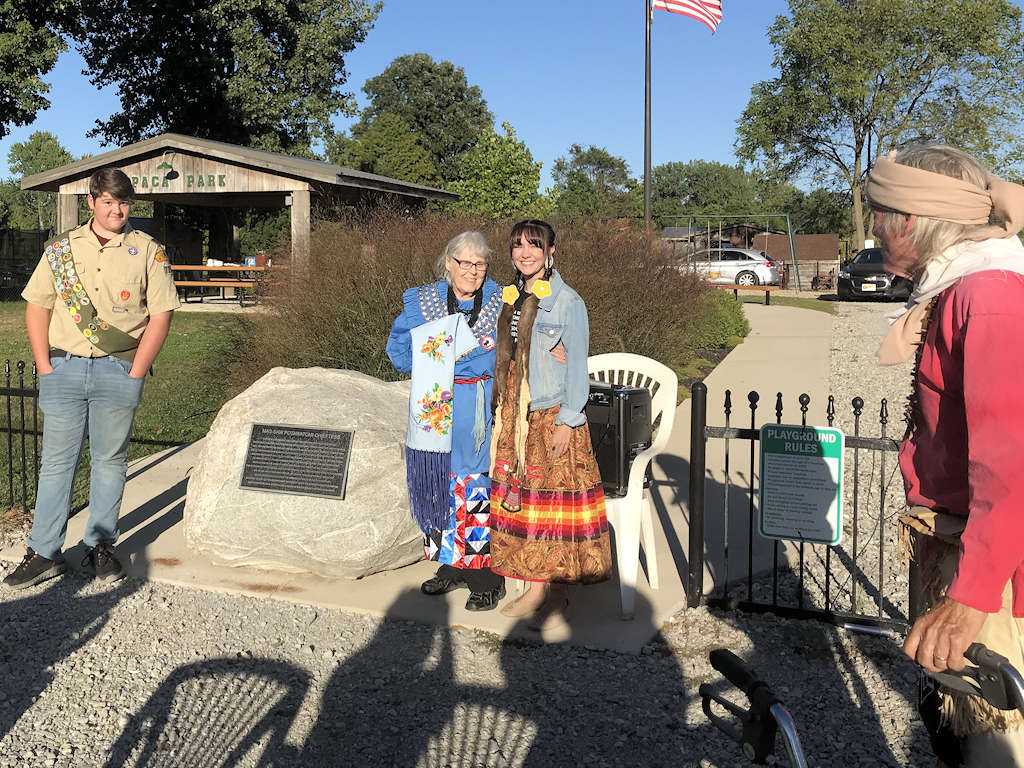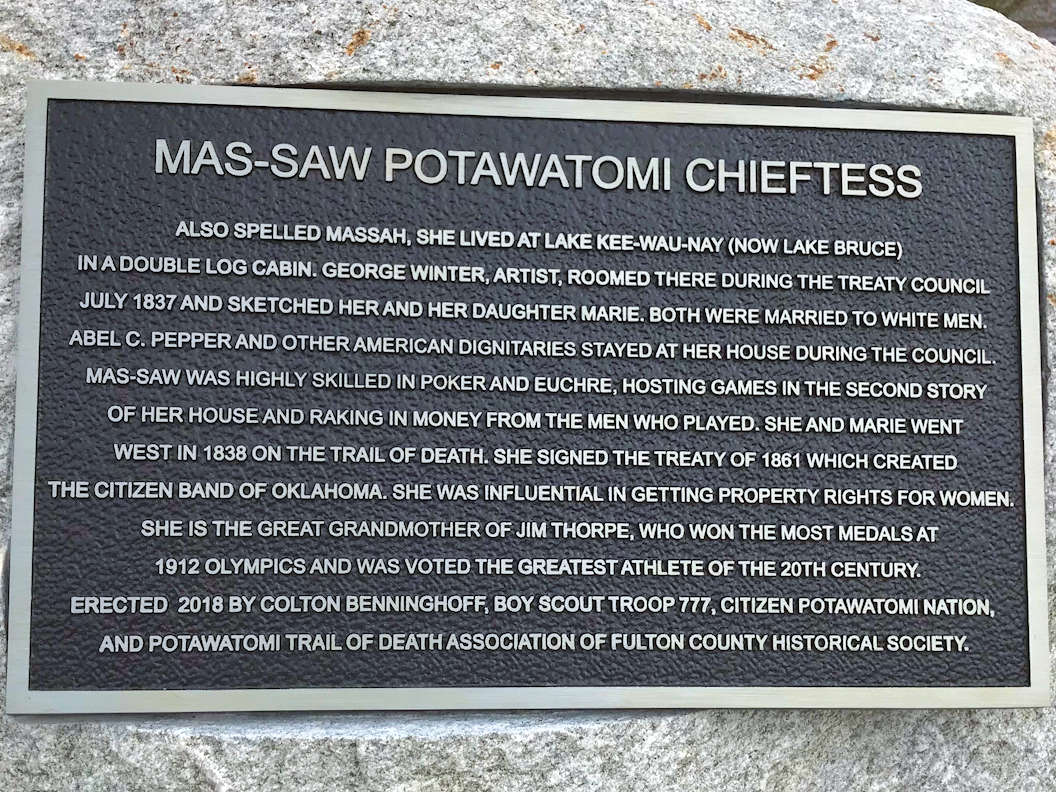|
Mas-saw (also spelled Massah) was a Potawatomi chieftess at Lake Kee-wau-nay, now called Lake Bruce, in Fulton County, Indiana. She had a log cabin and provided room and board to George Winter, the frontier artist who came to sketch the Treaty of 1837. Her rank of chieftess was inherited, through her father Wassato. Winter noted that she had uncommon intelligence, and her influence among the Indians was very observable. Winter made pencil sketches of the Indians at the treaty council and on the back of the sketches he wrote their names, the color and fabric of their clothing, what they said and what they did. Later he made oil paintings from his sketches. His paintings and sketches were published in books by the Indiana Historical Society in 1948 and 1993. Winter wrote that Mas-saw played euchre and poker. She was an adroit expert at poker and gambling, often raking men of experience who attended her “receptions” in the second floor of the cabin. Her cabin was the headquarters for the Indian Agent, Col. Abel C. Pepper, during the treaty council. Her name is attached to the long list of Indian chiefs, Head Men, and warriors in the treaty signed Aug. 5, 1837. However, this treaty was never ratified by Congress so it did not take effect and is not included in the official Treaty Book. Mas-saw’s cabin was a double log structure, substantially built, with two rooms upstairs and two rooms on the ground floor. A wide passage of nine feet separated the rooms both on the first and second floor. This log house was the place of general rendezvous for all the Indians who did not bring their camps with them. Winter called it a “log mansion.” Mas-saw had married a French Canadian, Andrew Gosselin. They had a daughter named Maurie, about age 14 at that time. Winter sketched Maurie too, and noted that she held an umbrella and a long handkerchief as she posed. Like her mother, Maurie was married to a white man, Henry Taylor, who worked for Ewing & Walker, traders in Logansport. He died sometime between the summer of 1837 and the forced removal in the fall of 1838. Maurie later married Thomas McKinney. During the time of the treaty councils, Mas-saw made considerable money providing room and board to the white men who attended. Besides Winter and Pepper, there was Col. L. H. Sands, George Profit (who conducted a group of Potawatomi to Kansas in the fall of 1837), Dr. Jerolaman (whose house is now the Cass County Museum), and Gardiner - an agent to secure Indian boys to attend Choctaw Academy in Kentucky. Winter reported that they had lively conversations around the table during meal time. Another Potawatomi woman named Doga helped Mas-saw with the cooking, which was done in Doga’s wigwam. Winter stayed at Mas-saw’s house for several days after the council ended, perfecting his sketches. He drew scenes of an Indian burial, and of the Indians playing several games. “Moccasin” was like a shell game in which one person turned three moccasins upside down and hid a trinket or stone under one moccasin, and the players had to guess which one it was under. Another game was “Yuh-youh-tche-chick” and was similar to quoits. They also had stare-downs called the Game of Wink. They would make bets on who would laugh or blink first. Mas-saw wore a cape covered with circular silver ornaments. Several strands of small blue-black beads hung around her neck. She wore a belt pendant and from it hung several steel chains and watch keys that hung nearly to her knees. Her skirt was adorned with rows of red and white ribbons, about two inches wide, cut into points and sewn neatly. Her shawl was blue and decorated with flowers. Leggings completed the handsome outfit. Mas-saw and her family went west with the emigration of the Potawatomi to Kansas in 1838, known as the Trail of Death. Winter sketched the scene of the camp at Mud Creek, showing tripods with small kettles as the Indians cooked their supper. He also sketched their last Mass held at their camp in Logansport about where the hospital is now. And he sketched them as they headed west on Sept. 10, wending their way along the north bank of the Wabash River. Mas-saw continued her influence in Kansas and signed the Treaty of 1861, which created the Citizen Band by making them U.S. citizens and giving them land in Oklahoma. Because of her influence, that treaty has a clause giving the women equal rights with men. This was many years before white women were given those rights. But Mas-saw’s greatest achievement was something she never saw and could not have dreamed. Her great-grandson, Jim Thorpe, won the decathlon and pentathlon at the 1912 Olympics. He went on to star in football and baseball. He was the first president of the National Football League. And at the end of the 20th century, he was voted the World’s Greatest Athlete by the nation’s press and sports announcers. Mas-saw’s younger daughter Elizabeth Goslin married Louis Vieux’s son Jacob Vieux; their daughter Charlotte married Hiram Thorpe and gave birth to Jim Thorpe in 1887. 
Historical marker to memorialize Mas-saw in PACA Park at Lake Bruce was erected by Boy Scout Colton Benninghoff in 2020. Shirley Willard, Fulton County Historical Society, is wearing a copy of Mas-saw’s dress from the pictures made by George Winter in 1837. Erin Locke and George Godfrey, members of Citizen Band Potawatomi, at right. Click image for larger view. 
Mas-saw memorial plaque is in PACA Park at Lake Bruce, Fulton County, Indiana. Click image for larger view. |
| < Previous | Home | Next > |